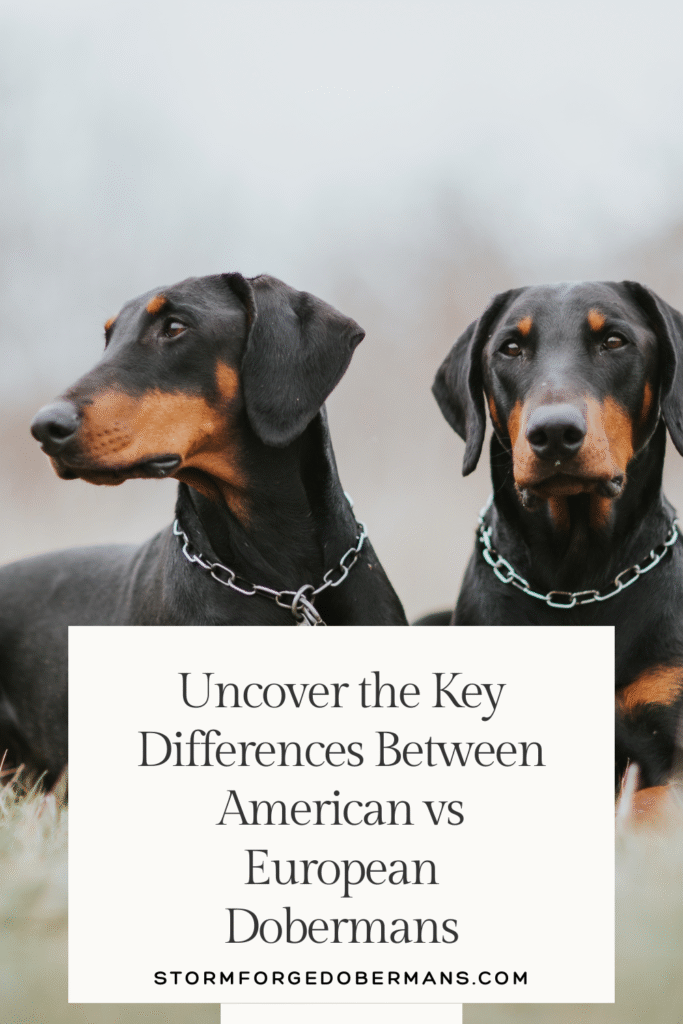American vs European Doberman is one of the most common comparisons made by dog lovers considering this iconic breed. Both share the sleek, powerful appearance and loyal nature Dobermans are famous for, but there are important differences that can influence your choice depending on your lifestyle, experience, and goals. Understanding these distinctions will help you select the best dog for your needs.
American Dobermans tend to be bred with an emphasis on companionship, show qualities, and temperament. They usually have a leaner frame, with refined features and a friendly, eager-to-please personality that fits well into family life or competitive dog sports. Their adaptability makes them a favorite among pet owners across the United States.
In contrast, European Dobermans are often bred for work, protection, and durability. Originating from Germany and surrounding regions, these dogs generally have a more robust build and a reserved, alert temperament. They excel in roles such as police work and personal protection but typically require experienced handling and consistent training to thrive.
Choosing between an American vs European Doberman means carefully considering what kind of companion or working dog you want. This guide offers a detailed side-by-side comparison of their history, physical traits, temperament, and training needs to help you make an informed decision.
With so much information out there, cutting through the noise with clear, trustworthy insights is vital. Let’s explore the key differences between American vs European Dobermans to find the right fit for your home and lifestyle.
American vs European Doberman: Key Physical Differences
American Doberman:
- Build: American Dobermans are generally leaner and more refined compared to their European counterparts, with a lighter bone structure and a streamlined appearance.
- Size: Males typically stand between 68 to 71 cm at the shoulder, while females stand around 63 to 68 cm. Males weigh between 34 to 45 kg, and females weigh between 27 to 39 kg.
- Coat and Color: American Dobermans have a sleek, short coat in colors including black and tan, red and tan, blue and tan, and fawn and tan. They are often bred with a focus on conformational standards for dog shows.
European Doberman:
- Build: European Dobermans are usually more robust and muscular, with a thicker bone structure and a powerful appearance, reflecting their working dog heritage.
- Size: European Dobermans are generally larger and heavier. Males typically stand between 71 to 76 cm at the shoulder and weigh between 40 to 50 kg. Females stand around 66 to 71 cm and weigh between 30 to 40 kg.
- Coat and Color: European Dobermans have a short, dense coat similar in color to the American variety but often thicker, suited to their working roles.
Temperament Comparison: American vs European Dobermans
American Doberman:
- Personality: American Dobermans are known for their friendly and outgoing nature. They are often bred with an emphasis on conformation and family-friendly traits, making them excellent companions for families and individuals.
- Training and Socialization: They are highly trainable and eager to please. Their temperament generally makes them suitable for obedience training and various dog sports.
- Guarding Instincts: While protective, American Dobermans usually have a more balanced approach to guarding, making them adaptable to family life.
European Doberman:
- Personality: European Dobermans tend to have a more serious and reserved demeanor. Bred with a focus on working abilities, they often exhibit a more intense and driven personality.
- Training and Socialization: These Dobermans are highly intelligent and require firm, consistent training. Their working background makes them excellent candidates for protection work and police training.
- Guarding Instincts: European Dobermans possess a stronger instinct for guarding and protection. Their training often emphasizes these traits, making them well-suited for roles in security and protection.
Health and Longevity: American vs European Dobermans
American Doberman:
- Health Issues: American Dobermans may be prone to certain genetic conditions, such as dilated cardiomyopathy (a heart condition) and hip dysplasia. Regular health screenings and responsible breeding practices help mitigate these risks.
- Longevity: The lifespan of American Dobermans typically ranges from 10 to 12 years, though this can vary depending on overall health and care.
European Doberman:
- Health Issues: European Dobermans also face risks of similar genetic conditions. They are often bred with a focus on working ability, which can sometimes lead to different health concerns, including those related to joint and muscle health.
- Longevity: The lifespan of European Dobermans is similar to their American counterparts, typically ranging from 10 to 12 years, depending on health and care.
Training Considerations for American vs European Dobermans
When comparing American vs European Dobermans, understanding their training needs is crucial for a successful relationship. American Dobermans are generally known for their eagerness to please and adaptability, making them highly trainable companions for families and first-time Doberman owners. Their temperament often lends itself well to obedience training, agility, and various dog sports, where positive reinforcement techniques thrive.
European Dobermans, on the other hand, often have a stronger work drive and more intense protection instincts due to their breeding focus on working roles. This means they typically require more consistent, experienced handling and firm but fair training methods to channel their energy and intelligence appropriately. Socialisation from an early age is especially important to help these dogs develop balanced behavior and confidence in different environments.
Regardless of the line you choose, both American and European Dobermans benefit from early and ongoing training that emphasizes clear communication, structure, and mental stimulation. Incorporating regular exercise and enrichment activities will help prevent boredom and undesirable behaviors, ensuring your Doberman thrives as a well-mannered and happy member of your family.
Choosing the Right Doberman for You
When choosing between an American and European Doberman, consider your lifestyle, preferences, and what you are looking for in a companion. American Dobermans may be ideal for families and individuals seeking a friendly, trainable pet with show-quality traits.
In contrast, European Dobermans are well-suited for those interested in a more robust working dog with strong guarding instincts.
Embracing Doberman Diversity
Both American and European Dobermans have unique qualities that make them exceptional dogs. Understanding their differences helps in making an informed choice and ensures that you select a Doberman that aligns with your needs and lifestyle.
Whether you’re drawn to the refined appearance and friendly nature of the American Doberman or the powerful build and serious demeanor of the European Doberman, you’re sure to find a loyal and intelligent companion.
For those seeking further authoritative information on Dobermans, several excellent resources are available. The Doberman Pinscher Club of America offers comprehensive breed standards, health information, and community support. For detailed breed insights and care tips, Doberman Planet provides a wealth of expert articles and owner experiences. The American Kennel Club (AKC) also features extensive breed profiles and training advice. Australian owners may find valuable guidance through the Australian National Kennel Council (ANKC), which oversees breed standards and canine welfare nationally. Linking to these trusted sites enriches your readers’ experience and strengthens your post’s credibility.
If you’re considering adding a Doberman to your family or training program, understanding the differences between American and European lines is just the beginning. Take the time to explore our other detailed guides on Doberman care, training, and health to make an informed decision. Have questions or experiences to share? Leave a comment below—we love hearing from fellow Doberman enthusiasts! Don’t forget to subscribe to our newsletter for expert tips, exclusive updates, and more helpful resources delivered straight to your inbox.

